Near-Earth object: Difference between revisions
m Corrected bad link to spacecentre.co.uk NEO's page |
|||
| Line 171: | Line 171: | ||
* [http://www.spaceguarduk.com/ Spaceguard UK] |
* [http://www.spaceguarduk.com/ Spaceguard UK] |
||
* [http://starrymirror.com/neo%20hearing1109.htm House Holds Hearing On NEO Threat] |
* [http://starrymirror.com/neo%20hearing1109.htm House Holds Hearing On NEO Threat] |
||
* The UK [http://www.spacecentre.co.uk/ |
* The UK [http://www.spacecentre.co.uk/Page.aspx/6/NEAR_EARTH_OBJECTS/ NEO Information Centre] |
||
* [http://www.arm.ac.uk/preprints/455.pdf Earth in the Cosmic Shooting Gallery] Paper published 2005 |
* [http://www.arm.ac.uk/preprints/455.pdf Earth in the Cosmic Shooting Gallery] Paper published 2005 |
||
* [http://www.astronomycast.com/astronomy/episode-29-asteroids-make-bad-neighbors/ Near Earth Asteroids] [[Astronomy Cast]] episode #29, includes full transcript. |
* [http://www.astronomycast.com/astronomy/episode-29-asteroids-make-bad-neighbors/ Near Earth Asteroids] [[Astronomy Cast]] episode #29, includes full transcript. |
||
Revision as of 17:47, 2 November 2009

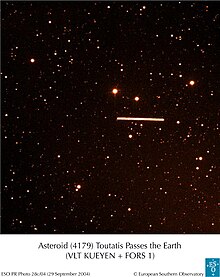
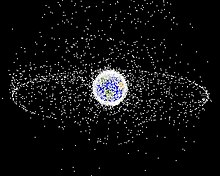
A near-Earth object (NEO) is a Solar System object whose orbit brings it into close proximity with the Earth. All NEOs have a perihelion distance < 1.3 AU.[1] They include a few thousand near-Earth asteroids (NEAs), near-Earth comets, a number of solar-orbiting spacecraft, and meteoroids large enough to be tracked in space before striking the Earth. It is now widely accepted that collisions in the past have had a significant role in shaping the geological and biological history of the planet. NEOs have become of increased interest since the 1980s because of increased awareness of the potential danger some of the asteroids or comets pose to the Earth, and active mitigations are being researched. A study showed that the United States and China are the nations most vulnerable to a meteor strike.[2]
Those NEOs that are asteroids (NEA) have orbits that lie partly between 0.983 and 1.3 astronomical units away from the Sun.[3] When an NEA is detected it is submitted to the Harvard Minor Planet Center for cataloging. Some near-Earth asteroids' orbits intersect that of Earth's so they pose a collision danger.[4] The United States, European Union and other nations are currently scanning for NEOs[5] in an effort called Spaceguard. In the United States, NASA has a congressional mandate to catalogue all NEOs that are at least 1 kilometer wide, as the impact of such an object would be expected to produce severe to catastrophic effects. As of October 2008[update], 982 of these mandated NEOs have been detected.[6] It was estimated in 2006 that 20% of the mandated objects have not yet been found.[5] Efforts are under way to use an existing telescope in Australia to cover the ~30% of the sky that has not yet been surveyed.
Potentially hazardous objects (PHOs) are currently defined based on parameters that measure the object's potential to make threatening close approaches to the Earth. Mostly objects with an Earth minimum orbit intersection distance (MOID) of 0.05 AU or less and an absolute magnitude (H) of 22.0 or less (a rough indicator of large size) are considered PHOs. Objects that cannot approach closer to the Earth (i. e. MOID) than 0.05 AU (roughly 7,480,000 km or 4,650,000 mi), or are smaller than about 150 m (500 ft) in diameter (i. e. H = 22.0 with assumed albedo of 13%), are not considered PHOs.[7] The NASA Near Earth Object Catalog also includes the approach distances of asteroids and comets measured in Lunar Distances, and this usage has become the more usual unit of measure used by the press and mainstream media in discussing these objects.
Some NEOs are of high interest because they can be physically explored with lower mission velocity even than the Moon, due to their combination of low velocity with respect to Earth (ΔV) and small gravity, so they may present interesting scientific opportunities both for direct geochemical and astronomical investigation, and as potentially economical sources of extraterrestrial materials for human exploitation.[8] This makes them an attractive target for exploration.[9] As of 2008, two near-Earth objects have been visited by spacecraft: 433 Eros, by NASA's Near Earth Asteroid Rendezvous probe,[10] and 25143 Itokawa, by the JAXA Hayabusa mission.[11]
Classification of near-Earth objects by kind and size
Near-Earth meteoroids
Near Earth Meteoroids are objects with orbits in the vicinity of Earth's orbit having a diameter less than 50 metres.
Near-Earth asteroids
These are objects that have a near-Earth orbit, yet far enough from the Sun so that the surface material never evaporates, having a diameter over 50 metres. As of August 5, 2009, 6,244 near-Earth asteroids are known, ranging in size up to ~32 kilometers (1036 Ganymed).[12][13] The number of near-Earth asteroids over one kilometer in diameter is estimated to be 500 - 1,000.[14][15] The composition of near-Earth asteroids is comparable to that of asteroids from the main asteroid belt, reflecting a variety of asteroid spectral types.[16]
NEAs only survive in their orbits for a few million years.[3] They are eventually eliminated by orbital decay and accretion by the Sun, collisions with the inner planets, or by being ejected from the solar system by close-approaches with the planets. With orbital lifetimes short compared to the age of the solar system, new asteroids must be constantly moved into near-Earth orbits to explain the observed asteroids. The accepted origin of these asteroids is that main belt asteroids are moved into the inner solar system through orbital resonances with Jupiter. The interaction with Jupiter through the resonance perturbs the asteroid's orbit and it comes into the inner solar system. The asteroid belt has gaps, known as Kirkwood gaps, where these resonances occur as the asteroids in these resonances have been moved onto other orbits. New asteroids migrate into these resonances due to the Yarkovsky effect that provides a continuing supply of near-Earth asteroids.[17]
A small number of NEOs are extinct comets that have lost their volatile surface materials. Also, having sometimes a faint comet-like tail does not necessarily result in a classification as a Near Earth Comet, making the boundaries somewhat fuzzy. The rest of the near-Earth asteroids are driven out of the asteroid belt by gravitational interactions with Jupiter.[3][18]
There are three families of near-Earth asteroids:[3]
- The Atens, which have average orbital radii closer than one AU[19] and aphelia of greater than Earth's perihelion (0.983 AU), placing them usually inside the orbit of Earth.
- The Apollos, which have average orbital radii greater than that of the Earth and perihelia less than Earth's aphelion (1.017 AU).
- The Amors, which have average orbital radii in between the orbits of Earth and Mars and perihelia slightly outside Earth's orbit (1.017 - 1.3 AU). Amors often cross the orbit of Mars, but they do not cross the orbit of Earth.
Many Atens and all Apollos have orbits that cross that of the Earth, so they are a threat to impact the Earth on their current orbits. Amors do not cross the Earth's orbit and are not immediate impact threats. However, their orbits may evolve into Earth-crossing orbits in the future.
Also sometimes used is the Arjuna asteroid classification for asteroids with extremely Earth-like orbits.[20]
Near-Earth comets
As of December 31, 2008, 82 near-Earth comets have been discovered. Although no impact of a comet in earth history has been conclusively confirmed, the Tunguska event may have been caused by a fragment of Comet Encke.[21] Cometary fragmenting may also be responsible for some impacts from near earth objects.
These near-Earth objects were probably derived from the Kuiper belt, a repository of comets residing beyond the orbit of Neptune.
Planet Earth collision probability with near-Earth objects
Impact rate
Objects with diameters of 5-10m impact the Earth's atmosphere approximately once per year, with as much energy as the atomic bomb dropped on Hiroshima, approximately 15 kilotonnes of TNT. These ordinarily explode in the upper atmosphere, and most or all of the solids are vaporized.[22] Objects of diameters of the order of 50 meters strike the Earth approximately once every thousand years, producing explosions comparable to the one observed at Tunguska in 1908.[23] Objects with a diameter of one kilometer hit the Earth an average of twice every million year interval.[3] Large collisions with five kilometer objects happen approximately once every ten million years.
Historic impacts

The general acceptance of the Alvarez hypothesis, explaining the Cretaceous–Tertiary extinction event as the result of a large object impact event, raised the awareness of the possibility of future Earth impacts with other objects that cross the Earth's orbit.[23]
1908 Tunguska Event
It is now commonly believed that on 30 June 1908 a stony asteroid exploded over Tunguska with the energy of the explosion of 10 megatons of TNT. The explosion occurred at a height of 8.5 kilometers. The object that caused the explosion has been estimated to have had a diameter of 45-70 meters.[24]
2002 Eastern Mediterranean event
On June 6, 2002 an object with an estimated diameter of 10 meters collided with Earth. The collision occurred over the Mediterranean Sea, between Greece and Libya, at approximately 34°N 21°E and the object exploded in mid-air. The energy released was estimated (from infrasound measurements) to be equivalent to 26 kilotons of TNT, comparable to a small nuclear weapon.[25]
2008 Sudan event
On 5 October 2008, scientists calculated that a small Near-Earth asteroid 2008 TC3 just sighted that night should impact the Earth on 6 October over Sudan, at 0246 UTC, 5:46 local time.[26][27] The asteroid arrived as predicted.[28][29] This is the first time that an asteroid impact on Earth has been accurately predicted. However, no reports of the actual impact have so far been published since it occurred in a very sparsely populated area.[30] The object is confirmed to have entered Earth's atmosphere as a meteor above northern Sudan at a velocity of 12.8 kilometres per second (29,000 mph).
Close approaches
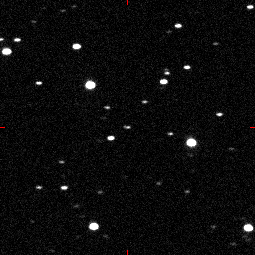
On August 10, 1972 a meteor that became known as The Great Daylight 1972 Fireball was witnessed by many people moving north over the Rocky Mountains from the U.S. Southwest to Canada. It was an Earth-grazing meteoroid that passed within 57 kilometres (about 34 miles) of the Earth's surface. It was filmed by a tourist at the Grand Teton National Park in Wyoming with an 8-millimeter color movie camera.[31]
On March 23, 1989 the 300 meter (1,000-foot) diameter Apollo asteroid 4581 Asclepius (1989 FC) missed the Earth by 700,000 kilometers (400,000 miles) passing through the exact position where the Earth was only 6 hours before. If the asteroid had impacted it would have created the largest explosion in recorded history, thousands of times more powerful than the Tsar Bomba, the most powerful nuclear bomb ever exploded by man. It attracted widespread attention as early calculations had its passage being as close as 64,000 km (40,000 miles) from the Earth, with large uncertainties that allowed for the possibility of it striking the Earth.[32]
On March 18, 2004, LINEAR announced a 30 meter asteroid 2004 FH, which would pass the Earth that day at only 42,600 km (26,500 miles), about one-tenth the distance to the moon, and the closest miss ever noticed. They estimated that similar sized asteroids come as close about every two years.[33]
On March 31, 2004, two weeks after 2004 FH, meteoroid 2004 FU162 set a new record for closest recorded approach, passing Earth only 6,500 km (4,000 miles) away (about one-sixtieth of the distance to the Moon). Because it was very small (6 meters/20 feet), FU162 was detected only hours before its closest approach. If it had collided with Earth, it probably would have harmlessly disintegrated in the atmosphere.
On March 2, 2009, a near-Earth asteroid, Asteroid DD45 2009 flew by Earth at about 8:40 a.m. ET (1340 UT). The estimated distance from Earth was 72,000 km (44,740 miles); approximately twice the height of a geostationary communications satellite. The estimated size of the space rock was about 35 meters (115 feet) wide.[34]
Future impacts
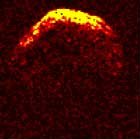
Although there have been a few false alarms, a number of objects have been known to be threats to the Earth. (89959) 2002 NT7 was the first asteroid with a positive rating on the Palermo Technical Impact Hazard Scale, with approximately one in a million on a potential impact date of February 1, 2019.
Asteroid (29075) 1950 DA was lost after its discovery in 1950 since not enough observations were made to allow plotting of its orbit, and then rediscovered on December 31, 2000. The chance it will impact Earth on March 16, 2880 during its close approach has been estimated as 1 in 300. This chance of impact for such a large object is roughly 50% greater than that for all other such objects combined between now and 2880.[35] It has a diameter of about a kilometer (0.6 miles).
The asteroids 99942 Apophis (provisionally known as 2004 MN4), 2007 VK184, and 2008 AF4 have had above-normal rankings on the Torino Scale.
Projects to minimize the threat
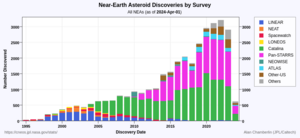
Astronomers have been conducting surveys to locate the NEOs. One of the best-known is LINEAR that began in 1996. By 2004 LINEAR was discovering tens of thousands of objects each year and accounting for 65% of all new asteroid detections.[36] LINEAR uses two one-meter telescopes and one half-meter telescope based in New Mexico.[37]
Spacewatch, which uses a 90 centimeter telescope sited at the Kitt Peak Observatory in Arizona, updated with automatic pointing, imaging, and analysis equipment to search the skies for intruders, was set up in 1980 by Tom Gehrels and Dr. Robert S. McMillan of the Lunar and Planetary Laboratory of the University of Arizona in Tucson, and is now being operated by Dr. McMillan. The Spacewatch project has acquired a 1.8 meter telescope, also at Kitt Peak, to hunt for NEOs, and has provided the old 90 centimeter telescope with an improved electronic imaging system with much greater resolution, improving its search capability.[38]
Other near-earth object tracking programs include Near-Earth Asteroid Tracking (NEAT), Lowell Observatory Near-Earth-Object Search (LONEOS), Catalina Sky Survey, Campo Imperatore Near-Earth Objects Survey (CINEOS), Japanese Spaceguard Association, and Asiago-DLR Asteroid Survey.[39]
NEOSSat is a micro satellite by Canada's CSA that will hunt for NEOs from space.
"Spaceguard" is the name for these loosely affiliated programs, some of which receive NASA funding to meet a U.S. Congressional requirement to detect 90% of near-earth asteroids over 1 km diameter by 2008.[40] A 2003 NASA study of a follow-on program suggests spending US$250–450 million to detect 90% of all near-earth asteroids 140 meters and larger by 2028.[41]
Research published in the March 26, 2009 issue of the journal Nature, describes how scientists were able to identify an asteroid in space before it entered Earth’s atmosphere, enabling computers to determine its area of origin in the solar system as well as predict the arrival time and location on Earth of its shattered surviving parts. The four-meter-diameter asteroid, called 2008 TC3, was initially sighted by the automated Catalina Sky Survey telescope, on October 6, 2008. Computations correctly predicted impact would occur 19 hours after discovery in the Nubian Desert of northern Sudan.[42]
Impact calculation error pattern

Impact predictions often make the news with the initial observations showing an increasing chance of impact, but then further observations ruling out any impact. The reason for this pattern is shown in the diagram at right. The ellipses in this diagram show the likely object position at closest earth approach. At first, with only a few observations, the error ellipse is very large and includes the Earth. This leads to a small, but non-zero, impact probability. Further observations shrink the error ellipse, but it still includes the Earth. This raises the impact probability, since the Earth now covers a larger fraction of the error region. Finally, yet more observations (often radar observations, or discovery of a previous sighting of the same object on archival images) shrink the ellipse still further. Now the earth is outside the error region, and the impact probability returns to near zero.[43]
Number of near-earth objects
As of August 2009[update], 6,244 NEOs have been discovered: 65 near-Earth comets and 5,409 near-Earth Asteroids. Of those there are 453 Aten asteroids, 2,053 Amor asteroids, and 2,894 Apollo asteroids. There are 943 NEOs that are classified as Potentially Hazardous Asteroids (PHAs). Currently, 138 PHAs and 743 NEAs have an absolute magnitude of 17.75 or brighter, which roughly corresponds to at least 1 km in size.[44]
The rate of impacts of objects of at least 1 km in diameter is estimated as 2 per million years. Assuming that this rate will continue for the next billion years, there exist at least 2,000 objects of diameter greater than 1 km that will eventually hit Earth. However, most of these are not yet considered Potentially Hazardous Objects because they are currently orbiting between Mars and Jupiter. Eventually they will change orbits and become NEOs. Objects spend on average a few million years as NEOs before hitting the Sun, being ejected from the Solar System, or (for a small proportion) hitting a planet.[45]
As of November 2008[update], there are 191 NEAs on the impact risk page at the NASA website.[44] A significant number of these NEAs – 121 as of February 2008[update] – are equal to or smaller than 50 meters in diameter and none of the listed objects are placed even in the "yellow zone" (Torino Scale 2), meaning that none warrant the attention of general public. As of April 2008[update], only one asteroid 2007 VK184 is listed as having Torino Scale score 1. As of May 2008[update], asteroid 2008 AF4 was downgraded to Torino Scale 0.[46][47]
Estimating the risks
There are two schemes for classification of impact hazards:
- the simple Torino Scale, and
- the more complex Palermo Technical Impact Hazard Scale
The annual background frequency used in the Palermo scale for impacts of energy greater than E megatonnes is estimated as:
For instance, this formula implies that the expected value of the time from now till the next impact greater than 1 megatonne is 33 years, and that when it occurs, there is a 50% chance that it will be above 2.4 megatonnes. This formula is only valid over a certain range of E.
However, another paper[48] published in 2002 – the same year as the paper on which the Palermo scale is based – found a power law with different constants:
This formula gives considerably lower rates for a given E. For instance, it gives the rate for bolides of 10 megatonnes or more (like the Tunguska explosion) as 1 per thousand years, rather than 1 per 210 years as in the Palermo formula. However, the authors give a rather large uncertainty (once in 400 to 1800 years for 10 megatonnes), due in part to uncertainties in determining the energies of the atmospheric impacts that they used in their determination.
On 25 December 2004, minor planet 2004 MN4 was assigned a 4 on the Torino scale, the highest rating so far. On 27 December 2004 there was a 2.7% chance of Earth impact on 13 April 2029. However, on 28 December 2004, the risk of impact dropped to zero for 2029, but, due to a resonant return possibility the Torino rating for an April 2036 impact rose to 4 in early 2005, and (as of August 2006[update]) has dropped gradually to a Torino rating of 0 (zero). The Palermo rating (August 2006) is −2.25.[49]
Currently, the only known NEO with a Palermo scale value greater than zero is (29075) 1950 DA, which is predicted to pass very close to or collide with the Earth (p ≤ 0.003) in the year 2880. Depending on the orientation of its axis of rotation, it will either miss the earth by tens of millions of kilometres, or have a 1 in 300 chance of hitting the earth. However, humanity has over 800 years to refine its estimates of the orbit of (29075) 1950 DA, and to deflect it, if necessary.
The Apollo asteroid 2007 TU24 approached Earth on January 29, 2008 with a distance of 1.4 LD (lunar distance), or 450,000 km, with an estimated size between 300-600 meters. It may be the closest asteroid to pass Earth until 2027.
NASA maintains a continuously updated web page of the most significant NEO threats in the next 100 years.[50] All or nearly all of the items on this page are highly likely to drop off the list eventually as more data comes in enabling more accurate predictions. (The page does not include 1950 DA, because that will not strike for at least 800 years.)
Detection from space
On November 8, 2007, the House Committee on Science and Technology's Subcommittee on Space and Aeronautics held a hearing to examine the status of NASA's Near-Earth Object survey program. The prospect of using the Wide-field Infrared Survey Explorer was proposed by NASA officials.[51]
WISE will survey the sky in the infrared band at a very high sensitivity. Asteroids that absorb solar radiation can be observed through the infrared band. NASA officials told Committee staff that NASA plans to use WISE to detect NEOs, in addition to performing its science goals. It is projected that WISE could detect 400 NEOs (roughly two percent of the estimated NEO population of interest) within the one-year mission.
See also
- 6Q0B44E
- Asteroid deflection strategies
- Bolide
- Co-orbital moon
- J002E3
- Mission Marco Polo
- NEODyS
- Orbit@home
- Space debris
- Tunguska event
References
- ^ Glossary of Astronomical Terms
- ^ Krajik, K. (2007) Killer Space Rocks. Popular Science magazine, September. pg 72-73.
- ^ a b c d e A. Morbidelli, W. F. Bottke Jr., Ch. Froeschlé, P. Michel (2002). W. F. Bottke Jr., A. Cellino, P. Paolicchi, and R. P. Binzel (ed.). "Origin and Evolution of Near-Earth Objects" (PDF). Asteroids III. University of Arizona Press: 409–422.
{{cite journal}}: Unknown parameter|month=ignored (help)CS1 maint: multiple names: authors list (link) - ^ Clark R. Chapman (2004). "The hazard of near-Earth asteroid impacts on earth". Earth and Planetary Science Letters. 222 (1): 1–15. doi:10.1016/j.epsl.2004.03.004. Retrieved 2007-10-22.
{{cite journal}}: Unknown parameter|month=ignored (help) - ^ a b Shiga, David (2006-06-27). "New telescope will hunt dangerous asteroids". New Scientist. Retrieved 2008-11-15.
- ^ "Unusual Minor Planets". Harvard Minor Planet Center. 2008-10-21. Retrieved 2008-10-21.
- ^ http://neo.jpl.nasa.gov/neo/groups.html
- ^ Dan Vergano (February 2, 2007). "Near-Earth asteroids could be 'steppingstones to Mars'". USA Today. Retrieved 2007-10-22.
- ^ Rui Xu, Pingyuan Cui, Dong Qiao and Enjie Luan (18 March 2007). "Design and optimization of trajectory to Near-Earth asteroid for sample return mission using gravity assists". Advances in Space Research. 40 (2): 200–225. doi:10.1016/j.asr.2007.03.025. Retrieved 2007-10-23.
{{cite journal}}: CS1 maint: multiple names: authors list (link) - ^ Donald Savage and Michael Buckley (January 31, 2001). "NEAR Mission Completes Main Task, Now Will Go Where No Spacecraft Has Gone Before". National Aeronautics and Space Administration. Retrieved 2007-10-22.
- ^ Don Yeomans (August 11, 2005). "Hayabusa's Contributions Toward Understanding the Earth's Neighborhood". National Aeronautics and Space Administration. Retrieved 2007-10-22.
- ^ "Unusual Minor Planets". Minor Planet Center.
- ^ Dr. David R. Williams (September 13 2006). "Near Earth Object Fact Sheet". National Aeronautics and Space Administration. Retrieved 2007-10-22.
{{cite web}}: Check date values in:|date=(help) - ^ Jane Platt (January 12, 2000). "Asteroid Population Count Slashed". National Aeronautics and Space Administration. Retrieved 2007-10-22.
{{cite web}}: Check date values in:|date=(help) - ^ David Rabinowitz, Eleanor Helin, Kenneth Lawrence and Steven Pravdo (13 January 2000). "A reduced estimate of the number of kilometre-sized near-Earth asteroids". Nature. 403: 165–166. doi:10.1038/35003128. Retrieved 2007-10-22.
{{cite journal}}: CS1 maint: multiple names: authors list (link) - ^ D.F. Lupishko and T.A. Lupishko (2001). "On the Origins of Earth-Approaching Asteroids". Solar System Research. 35 (3): 227–233. doi:10.1023/A:1010431023010. Retrieved 2007-10-23.
{{cite journal}}: Unknown parameter|month=ignored (help) - ^ A. Morbidelli, D. Vokrouhlický (2003). "The Yarkovsky-driven origin of near-Earth asteroids". Icarus. 163 (1): 120–134. doi:10.1016/S0019-1035(03)00047-2. Retrieved 2007-10-23.
{{cite journal}}: Unknown parameter|month=ignored (help) - ^ D.F. Lupishko, M. di Martino and T.A. Lupishko (2000). "What the physical properties of near-Earth asteroids tell us about sources of their origin?". Kinematika i Fizika Nebesnykh Tel Supplimen (3): 213–216.
{{cite journal}}: Unknown parameter|month=ignored (help) - ^ The distance from the Earth to the Sun
- ^ Ron Cowen (February 20, 1993). "Near-Earth asteroids: class consciousness - new asteroids identified". Science News. Retrieved 2007-10-23.
- ^ "The Tunguska object - A fragment of Comet Encke". Astronomical Institutes of Czechoslovakia. Retrieved 2007-10-15.
- ^ Clark R. Chapman & David Morrison (6 January 1994). "Impacts on the Earth by asteroids and comets: assessing the hazard". Nature. 367: 33–40. doi:10.1038/367033a0. Retrieved 2007-10-23.
- ^ a b Richard Monastersky (March 1, 1997). "The Call of Catastrophes". Science News Online. Retrieved 2007-10-23.
- ^ Christopher F. Chyba, Paul J. Thomas & Kevin J. Zahnle (January 7 1993). "The 1908 Tunguska explosion: atmospheric disruption of a stony asteroid". Nature. 361 (6407): 40–44. doi:10.1038/361040a0. Retrieved 2007-10-23.
{{cite journal}}: Check date values in:|date=(help) - ^ P. Brown, R.E. Spalding, D.O. ReVelle, E. Tagliaferri and S.P. Worden (21 November 2002). "The flux of small near-Earth objects colliding with the [[Earth]]" (PDF). Nature. 420 (6913): 294–296. doi:10.1038/nature01238. Retrieved 2007-10-23.
{{cite journal}}: URL–wikilink conflict (help)CS1 maint: multiple names: authors list (link) - ^ Don Yeomans (October 6, 2008). "Small Asteroid Predicted to Cause Brilliant Fireball over Northern Sudan". NASA/JPL Near-Earth Object Program Office. Retrieved 2008-10-09.
- ^ Richard A. Kerr (6 October 2008). "FLASH! Meteor to Explode Tonight". ScienceNOW Daily News. Retrieved 2008-10-09.
- ^ Don Yeomans (October 7, 2008). "Impact of Asteroid 2008 TC3 Confirmed". NASA/JPL Near-Earth Object Program Office. Retrieved 2008-10-09.
- ^ Richard A. Kerr (8 October 2008). "Asteroid Watchers Score a Hit". ScienceNOW Daily News. Retrieved 2008-10-09.
- ^ Little Asteroid Makes a Big Splash Sky and Telescope, October 9, 2008.
- ^ Grand Teton Meteor Video, Youtube
- ^ Brian G. Marsden (1998-03-29). "HOW THE ASTEROID STORY HIT: AN ASTRONOMER REVEALS HOW A DISCOVERY SPUN OUT OF CONTROL". The Boston Globe. Retrieved 2007-10-23.
- ^ Steven R. Chesley and Paul W. Chodas (March 17, 2004). "Recently Discovered Near-Earth Asteroid Makes Record-breaking Approach to Earth". National Aeronautics and Space Administration. Retrieved 2007-10-23.
{{cite web}}: Check date values in:|date=(help) - ^ Yahoo News - 20090302 - Asteroid Flies Past Earth
- ^ "Asteroid 1950 DA". National Aeronautics and Space Administration. Retrieved 2007-10-23.
- ^ Stokes, GStokes, G. (18 - 25 July, 2004). Detection and discovery of near-earth asteroids by the linear program. 35th COSPAR Scientific Assembly. Paris, France. p. 4338. Retrieved 2007-10-23.
{{cite conference}}: Check date values in:|date=(help); Unknown parameter|coauthors=ignored (|author=suggested) (help)CS1 maint: multiple names: authors list (link) - ^ "Lincoln Near-Earth Asteroid Research (LINEAR)". National Aeronautics and Space Administration. 23 October 2007.
- ^ "The Spacewatch Project". Retrieved 2007-10-23.
- ^ "Near-Earth Objects Search Program". National Aeronautics and Space Administration. 23 October 2007.
- ^ "NASA Releases Near-Earth Object Search Report". National Aeronautics and Space Administration. Retrieved 2007-10-23.
- ^ David Morrison. "NASA NEO Workshop". National Aeronautics and Space Administration.
- ^ We Saw It Coming: Asteroid Monitored from Outer Space to Ground Impact Newswise, Retrieved on March 26, 2009.
- ^ "Why we have Asteroid "Scares"". Spaceguard UK.
- ^ a b NEO Discovery Statistics
- ^ Morbidelli, A., W. F. Bottke, Ch. Froeschle, and P. Michel. 2002. Origin and evolution of near-Earth objects. In Asteroids III, (W. F. Bottke, A. Cellino, P. Paolicchi, R. Binzel, Eds). U. Arizona Press, 409-422.
- ^ Current Impact Risks
- ^ The Torino Impact Hazard Scale
- ^ "The flux of small near-Earth objects colliding with the Earth" by P. Brown et al., Nature, 420, pp. 294-6, November 2002.
- ^ "Current Impact Risks". Retrieved 2006-07-16.
- ^ NASA Near Earth Object Program Impact Risks Retrieved July 16, 2006
- ^ Hearing Charter: Near-Earth Objects: Status of the Survey Program and Review of NASA's 2007 Report to Congress | SpaceRef Canada - Your Daily Source of Canadian Space News
External links
- The Jet Propulsion Laboratory's NEO website
- Spaceguard UK
- House Holds Hearing On NEO Threat
- The UK NEO Information Centre
- Earth in the Cosmic Shooting Gallery Paper published 2005
- Near Earth Asteroids Astronomy Cast episode #29, includes full transcript.
- Upcoming Close Approaches (<0.10 A.U.) of Near-Earth Objects to Earth




